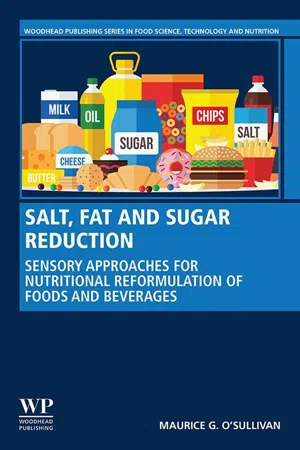
Salt, Fat and Sugar Reduction
Sensory Approaches for Nutritional Reformulation of Foods and Beverages
- 346 pages
- English
- ePUB (mobile friendly)
- Available on iOS & Android
Salt, Fat and Sugar Reduction
Sensory Approaches for Nutritional Reformulation of Foods and Beverages
About this book
Salt, Fat and Sugar Reduction: Sensory Approaches for Nutritional Reformulation of Foods and Beverages explores salt, sugar, fat and the current scientific findings that link them to diseases. The sensory techniques that can be used for developing consumer appealing nutritional optimized products are also discussed, as are other aspects of shelf life and physicochemical analysis, consumer awareness of the negative nutritional impact of these ingredients, and taxes and other factors that are drivers for nutritional optimization. This book is ideal for undergraduate and postgraduate students and academics, food scientists, food and nutrition researchers, and those in the food and beverage industries.- Provides a clear outline of current legislation on global ingredient taxes- Demonstrates effective protocols, sensory, multivariate and physico-chemical for salt, fat and sugar reduction- Outlines reduction protocols, with and without the use of replacer ingredients for salt, fat and sugar reduction- Illustrates the full process chain, consumer to packaging, and the effects of reformulation by reduction of ingredients
Frequently asked questions
- Essential is ideal for learners and professionals who enjoy exploring a wide range of subjects. Access the Essential Library with 800,000+ trusted titles and best-sellers across business, personal growth, and the humanities. Includes unlimited reading time and Standard Read Aloud voice.
- Complete: Perfect for advanced learners and researchers needing full, unrestricted access. Unlock 1.4M+ books across hundreds of subjects, including academic and specialized titles. The Complete Plan also includes advanced features like Premium Read Aloud and Research Assistant.
Please note we cannot support devices running on iOS 13 and Android 7 or earlier. Learn more about using the app.
Information
Understanding the requirement to reformulate; science, health, consumer demand, regulation, and capability
Abstract
Keywords
Introduction
| Sugar tax rates | |||||
|---|---|---|---|---|---|
| Lower rate | Higher rate | ||||
| Volume | Tax per pack | Plus VATa | Volume | Tax per pack | Plus VATa |
| 330 mL | +5c | +7c | Volume | +8c | +10c |
| 500 mL | +8c | +10c | 330 mL | +12c | +15c |
| 1.25 L | +20c | +25c | 500 mL | +31c | +38c |
| 1.5 L | +24c | +30c | 1.25 L | +37c | +45c |
| 1.75 L | +29c | +35c | 1.75 L | +43c | +53c |
| 2 L | +33c | +40c | 2 L | +49c | +60c |
| 4x330 mL | +22c | +26c | 4x330 mL | +32c | +40c |
| 6x330 mL | +32c | +40c | 6x330 mL | +48c | +59c |
Salt
Table of contents
- Cover image
- Title page
- Table of Contents
- Copyright
- Preface
- Acknowledgment
- Chapter one. Understanding the requirement to reformulate; science, health, consumer demand, regulation, and capability
- Chapter two. Nutritional optimization—reduced-sugar products and challenges
- Chapter three. Reduced-fat products and challenges
- Chapter four. Reduced-salt products and challenges
- Chapter five. Other nutritional modifications
- Chapter six. Descriptive methods for reformulation
- Chapter seven. Quantitative and qualitative affective methods for reformulation
- Chapter eight. Rapid sensory methods for reformulation
- Chapter nine. Discrimination testing for reformulated products
- Chapter ten. Validation and safety of reformulated products (shelf-life testing)
- Chapter eleven. Packaging and compensatory processes
- Chapter twelve. Magnitude estimation—alignment of sensory and instrumental analysis
- Index
